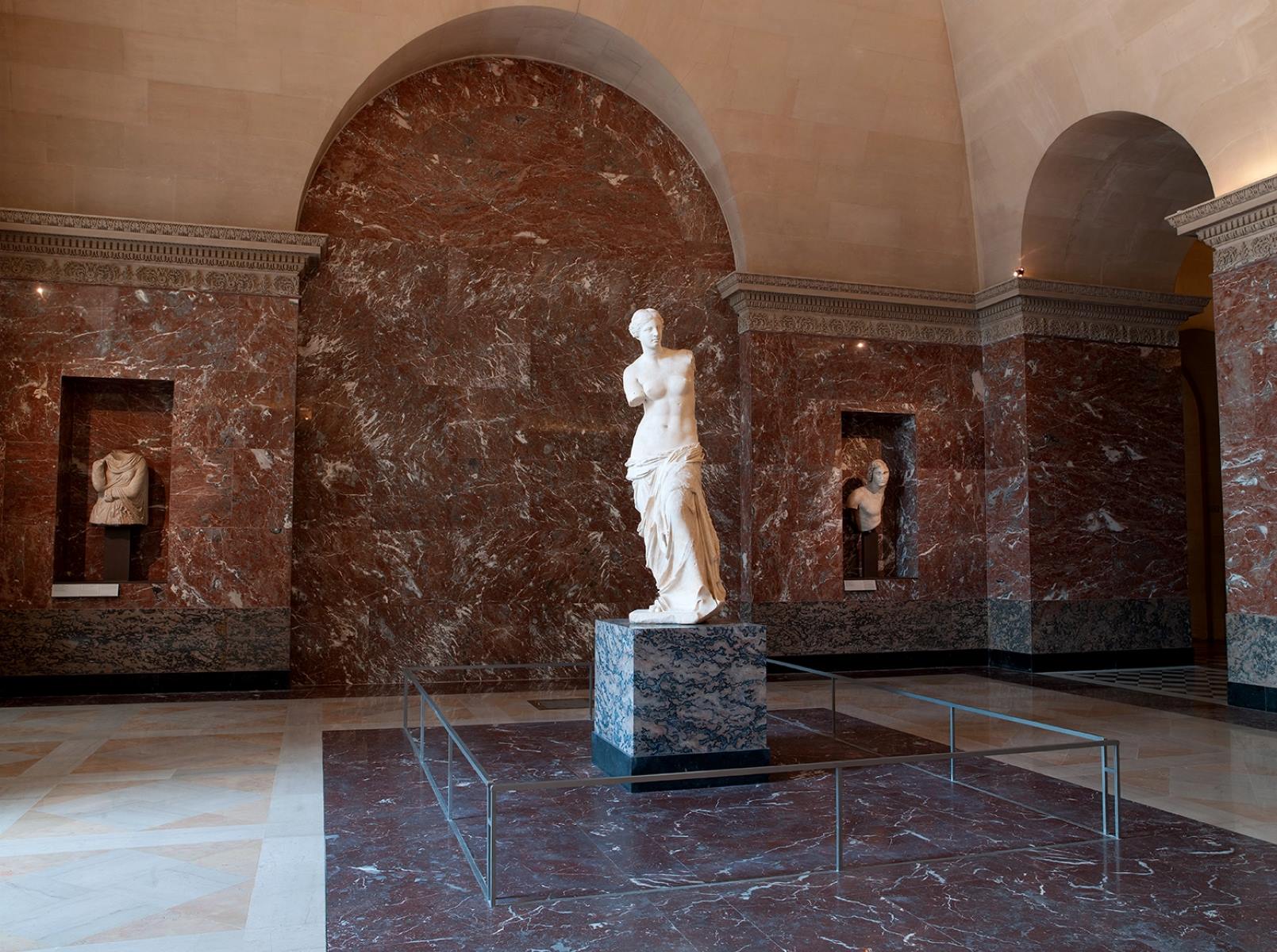
The Aphrodite statue, also known as the Venus de Milo, is one of the most iconic and renowned sculptures in the world. This ancient masterpiece has captivated art lovers and historians for centuries, with its enigmatic beauty and timeless charm. Believed to have been created by Alexandros of Antioch during the Hellenistic period, the Aphrodite statue continues to intrigue and inspire awe.In this article, we will delve into 14 fascinating facts about the Aphrodite statue, shedding light on its history, symbolism, and cultural significance. From its accidental discovery on the island of Milos to its current residence at the Louvre Museum in Paris, each fact unveils a unique aspect of this celebrated work of art. Get ready to uncover the enigmatic secrets and stories behind the Aphrodite statue, as we explore its journey through time and its enduring legacy in the world of art and sculpture.
Key Takeaways:
- The Aphrodite statue, also known as the Venus de Milo, was created in 130-100 BCE, stands 6 feet 8 inches tall, and is made of marble. It represents the goddess of love, beauty, and fertility, Aphrodite.
- The missing arms of the statue have sparked speculation, and it has influenced art, fashion, and culture. It has been on display at the Louvre Museum in Paris since 1821 and serves as an iconic symbol of female beauty.
The Birth of Aphrodite Statue
The famous Aphrodite statue, also known as the Venus de Milo, was believed to have been created during the Hellenistic period between 130 and 100 BCE. The statue depicts the Greek goddess of love, beauty, and fertility, Aphrodite.
Discovery
The Aphrodite statue was discovered on the island of Milos in 1820 by a peasant named Yorgos Kentrotas. It was found in several shattered pieces in an ancient theater, and its missing arms have never been recovered.
The Sculptor
Although the sculptor of the Aphrodite statue remains unknown, it is widely believed to be the work of Alexandros of Antioch. He was a renowned sculptor of the Hellenistic era who specialized in creating lifelike representations of the human form.
Measurements and Materials
The statue stands at a height of approximately 203 centimeters (6 feet 8 inches) and is made of marble. It is believed to have been created using the method of marble carving, where the sculptor carves away excess stone to reveal the desired form.
Mysterious Beauty
The missing arms of the Aphrodite statue have sparked much speculation over the centuries. Some believe that the statue may have originally held objects such as a mirror or an apple, while others suggest that the arms were sculpted separately and attached later.
Symbolism
Aphrodite, the goddess of love and beauty, is often depicted in art and mythology as a symbol of feminine grace and allure. The Aphrodite statue represents the idealized female form and embodies the concept of beauty and love.
Inspiration for Artists
The Aphrodite statue has been a source of inspiration for countless artists throughout history. Its graceful pose, delicate features, and timeless beauty have influenced the works of painters, sculptors, and poets across different artistic movements.
Exhibition at the Louvre
The Aphrodite statue has been on display at the Louvre Museum in Paris since It is one of the museum’s most iconic and cherished pieces, drawing millions of visitors from around the world who come to marvel at its exquisite craftsmanship.
Replicas and Adaptations
Due to the popularity and significance of the Aphrodite statue, numerous replicas and adaptations have been created. From miniature figurines to large-scale reproductions, these interpretations pay homage to the timeless allure of Aphrodite.
Archaeological Significance
The discovery of the Aphrodite statue on the island of Milos provided valuable insights into the artistic techniques and aesthetics of the Hellenistic period. It has contributed to our understanding of ancient Greek sculpture and the portrayal of female beauty.
Influence on Fashion
The elegance and grace of the Aphrodite statue have transcended the world of art and made an impact on the realm of fashion. Designers have drawn inspiration from its flowing drapery and sensual curves, incorporating elements of the statue into their creations.
Aphrodite’s Cultural Legacy
Aphrodite, the goddess of love, beauty, and desire, has left an indelible mark on Western culture. The Aphrodite statue serves as a reminder of the enduring power and influence of ancient Greek mythology in shaping our artistic and cultural heritage.
Artistic Restoration
Over the years, the Aphrodite statue has undergone extensive restoration to preserve its beauty and structural integrity. Skilled artisans and conservators have meticulously repaired and maintained the statue, ensuring that future generations can continue to appreciate its magnificence.
An Iconic Symbol
The Aphrodite statue stands as an iconic symbol of female beauty and the timeless allure of the goddess Aphrodite. Its captivating presence continues to evoke a sense of awe and wonder, reminding us of the rich cultural heritage of ancient Greece.
Conclusion
In conclusion, the Aphrodite statue is not only a breathtaking work of art but also holds a significant place in Greek mythology and history. Its creation and discovery have captivated the world, making it one of the most studied and revered sculptures in the world. From its mysterious origins to its unparalleled beauty, the Aphrodite statue continues to fascinate and intrigue both art enthusiasts and historians alike. Whether you are drawn to its aesthetic appeal or its symbolic representation of love and beauty, there is no denying the enduring allure of this ancient masterpiece.
FAQs
Q: How old is the Aphrodite statue?
A: The exact age of the Aphrodite statue is uncertain. It is believed to have been created during the late Hellenistic period, around the 2nd century BCE. Q: Where was the Aphrodite statue discovered?
A: The Aphrodite statue was discovered in 1820 on the Greek island of Melos, also known as Milo. It was found in several pieces and eventually reconstructed by French archaeologists.Q: Who created the Aphrodite statue?
A: The creator of the Aphrodite statue remains unknown. It is often attributed to the ancient Greek sculptor Alexandros of Antioch, but this attribution is speculative and debated among experts.Q: What is the significance of the Aphrodite statue?
A: The Aphrodite statue represents the ancient Greek goddess of love, beauty, and fertility. It symbolizes the idealized female form and embodies the concept of divine beauty in Greek mythological beliefs.Q: Is the Aphrodite statue on display?
A: Yes, the Aphrodite statue, also known as the Venus de Milo, is currently on display at the Louvre Museum in Paris, France. It is one of the museum’s most prized and popular exhibits.Q: How tall is the Aphrodite statue?
A: The Aphrodite statue stands at approximately 6 feet and 8 inches tall. It is made of white marble and showcases the skill and mastery of ancient Greek sculptors.
Aphrodite's influence extends far beyond her iconic statue. Explore the world of ancient art at auctions, where timeless treasures await. Discover fascinating facts about Venus, the Roman counterpart to Aphrodite, and her enduring allure. For history buffs, delve into the life and works of
Was this page helpful?
Our commitment to delivering trustworthy and engaging content is at the heart of what we do. Each fact on our site is contributed by real users like you, bringing a wealth of diverse insights and information. To ensure the highest standards of accuracy and reliability, our dedicated editors meticulously review each submission. This process guarantees that the facts we share are not only fascinating but also credible. Trust in our commitment to quality and authenticity as you explore and learn with us.


